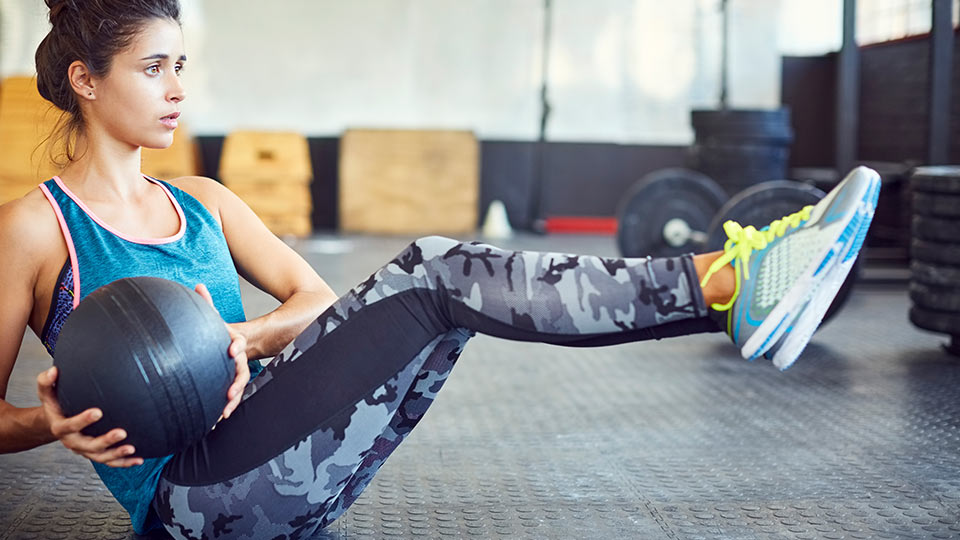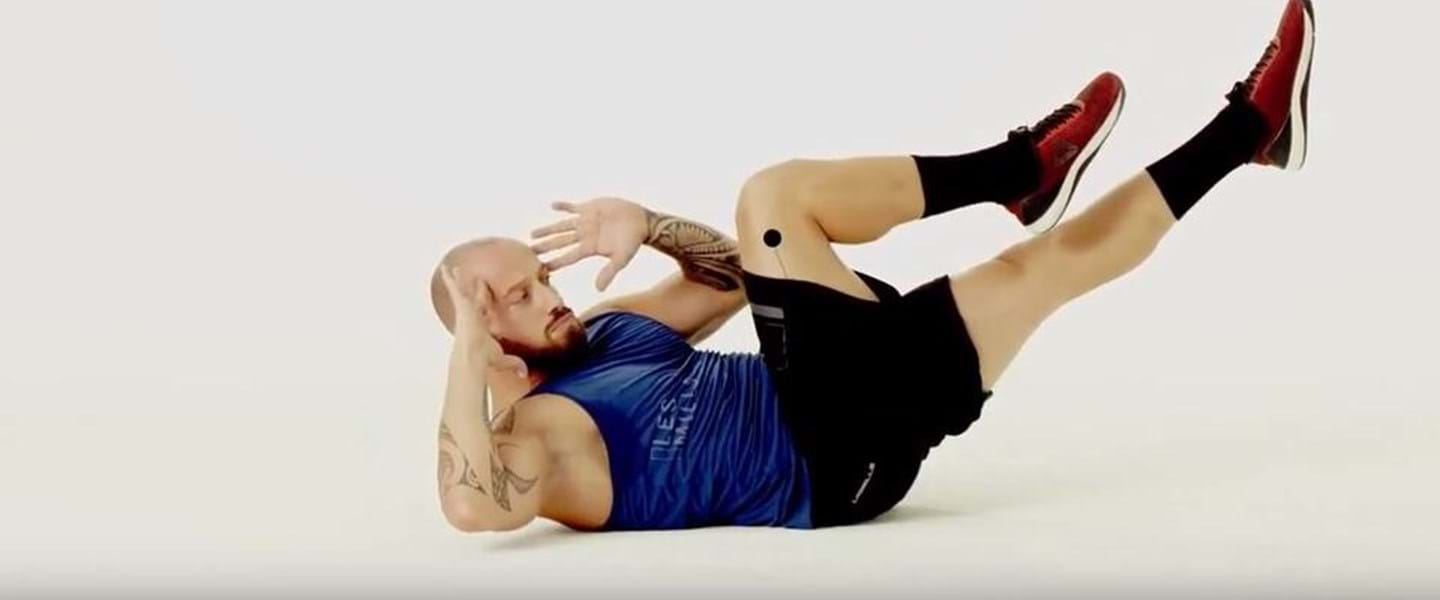If you’ve ever looked for ways to strengthen your obliques, you’ve probably come across the Russian Twist. It’s been touted as one of the most effective ways to trim the waistline and eliminate love handles … but often the risks far outweigh any such benefits.

The worst version of the Russian Twist is performed with the trunk and thighs lifted off the floor to create a V-shape with the back fully rounded; you then twist the torso from side to side with a heavy weight in your hands. This is not a good idea, says Bryce Hastings, physiotherapist and Les Mills Head of Research. Here he explains why …
What are the main problems with this Russian Twist exercise?
“The first issue is compression. Staying in that half sit-up position requires a massive contraction of the abdominals and hip flexors, which in turn produces excessive compression of the lumbar spine.
“The second issue is flexion. Because your back is not being supported by the floor, often you find yourself in full flexion, where the spine is rounded. The combination of compression and end-range flexion produces a lot of pressure on the spinal discs. In this position, the front of the vertebrae compress, which opens up the back of the lumbar spine, causing the disc fluid to move to the back. The analogy is this: the discs between our vertebrae consist of a series of fibrous rings with fluid in the center. Imagine the rings of an onion with the inside portion scooped out, with some toothpaste injected into the middle of the rings. When you compress the disc at the front, the toothpaste moves in the opposite direction to the compression. So the rounded back position creates lots of pressure, driving the disc fluid backwards, and eventually this pressure and stretching of the fibers at the back causes the onion rings to tear. From here, the onion rings begin to leak and the disc fluid can actually leak out from the middle of the disc.”
When you perform an exercise like the Russian Twist in full flexion you are effectively juicing your discs, but the fluid is meant to stay in the middle of the disc.
“The final issue is that the compression and flexion is combined with rotation. Imagine the pressure of juicing a lemon in a lemon squeezer… this is exactly what happens to the disc when you perform the Russian Twist. Each vertebra in the lumbar spine has only about three degrees of rotation, so when you try to produce a lot of rotation in your lumbar spine you are actually taking the joint to end-range rotation. This is like bouncing into a full crouch – your knee is not meant to go that far with that amount of joint stress.”
What are the risks of this type of Russian Twist?
“The short term risk is that you may experience pain performing the fully flexed Russian Twist. The long term consequences can be more serious. When you perform an exercise like this you are effectively juicing your discs, but the fluid is meant to stay in the middle of the disc. Think of your discs like the shock absorbers on a car. As long as the disc contains fluid it buffers the vertebrae apart so that everything is under tension. As soon as you start to lose the fluid integrity you will start to get leaks, and the vertebrae start to sit closer together. This causes all the other ligamentous tissues that are trying to maintain the position of the spine to buckle and become slack. This could lead to you experiencing back pain when you try to sit down. A more acute problem would mean that you’re actually unable to train. And the worst-case scenario would be a disc bulge – which may require surgery.”
What are the benefits of the Russian Twist?
“You can assess the effectiveness of any exercise by weighing up the risks versus the gains. The half sit-up position will create strain and stress on the abdominal muscles and if they fatigue you will get a training effect from this.”
“The rotation brings in additional stress which will also produce a training effect on the obliques. While the benefit is that you are producing some abdominal tension, you are simultaneously generating a lot of compression, flexion and rotation on the disc, which effectively just chews it up.”
You are producing some abdominal tension … but you are also generating compression, flexion and rotation on the disc … It’s just not worth the risk.”
What oblique exercises are better options?
“A great alternative for targeting your obliques is the Cross Crawl, which is ideal for anyone with lower back sensitivity or previous injury. The Cross Crawl keeps your lower back in contact with the floor, which means that it can’t rotate and flex as far. You’re most at risk when your back is unsupported, so keeping the lumbar spine on the floor ensures it won’t move into the dangerous territory of end-range flexion.”
“Stuart McGill, a renowned authority on spine biomechanics, is not a fan of Sit-Ups, crunches, or any similar variations. His recommendation is to keep the spine in neutral when training the core, and generate abdominal tension with moves such as Side Planks and Hovers. These exercises generate stress in the muscles without causing the same degree of joint stress to the lumbar spine – and therefore are a great alternative to the Russian Twist for anyone needing to reduce disc loading.”
Should you Plank or Hover?
Learn the subtle differences between the Plank and Hover and find out why the Hover is the integrated core training move that generates the greatest core activation. Read all about it.

“The cause and effect relationship of low back pain and Crunches/Sit-Ups is being taken seriously by those who need to perform at the top of their game. In 2009, a U.S. Army study replaced Sit-Ups with core stabilization exercises such as Planks. The result was that soldiers who performed Planks performed significantly better on their Sit-Up test.”
Of course hovers, planks and crunches aren’t the only core training options. Research shows that one BODYCOMBAT™ workout can provide the same core training benefit as 1,700 crunches. And a workout like CXWORX™ or LES MILLS CORE™ will introduce you to a dynamic range of integrated exercises that train all of your trunk muscles.
Find a workout work out on demand
Still love a Russian Twist?
If a Russian Twist is really your thing, make sure you follow these simple tips help reduce the risk:
- Keep your feet grounded. This will reduce the compression coming from the hip flexors
- Maintain a neutral lumbar spine by keeping the chest lifted and a slight inward curve in the lower back
- Once in this position, stabilize the trunk and legs and rotate through the center of the chest. Be sure to avoid rotating through the waist – this will generate rotation in the lumbar spine.
Bryce’s final word on the Russian Twist…
“As a physiotherapist, you can spend an entire day in the clinic and see nothing other than lumbar disc pain or lower back pain. A poorly performed Russian Twist is exactly the type of exercise that causes this type of pain – so it makes no sense to include it in your exercise regime.”
Learn more about the best core exercises in this complete ab guide.









